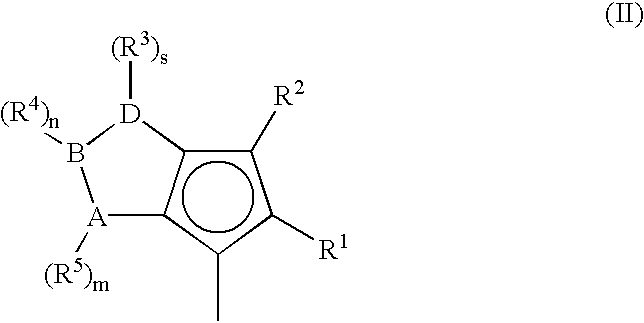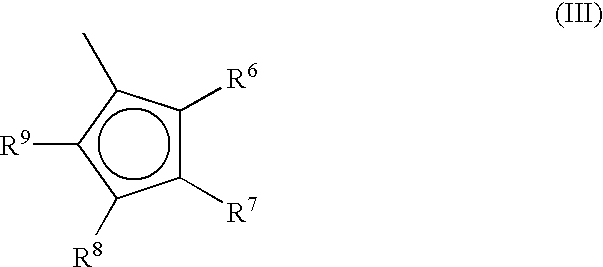Metallocene compounds, process for their preparation and their use in catalytic systems for the polymerization of olefins
a technology of olefin polymerization and metallocene, which is applied in the direction of catalyst activation/preparation, group 3/13 element organic compounds, and group 5/15 element organic compounds, etc., can solve the problems of low molecular weights that can be obtained at polymerization temperatures of industrial interest, and insufficient activity of metallocene-based catalysts
- Summary
- Abstract
- Description
- Claims
- Application Information
AI Technical Summary
Benefits of technology
Problems solved by technology
Method used
Image
Examples
example 1
Synthesis of Dimethylsilandiylbis-6-(2,5-dimethyl-3-phenylcyclotentadienyl-[1,2-b]-thiophene)zirconium Dichloride--{(2,5-Me.sub.2 -3-Ph-cyclopento[2,3-b]thiophen-6-yl).sub.2 SiMe.sub.2 }ZrCl.sub.2 (C3)
##STR16##
Synthesis of 3-Bromo-2-methylthiophene
To a solution containing 62.0 g (610 mmol, 88 mL) diisopropylamine dissolved in 150 mL THF was added a 2.5 M solution of butyllithium in hexane (610 mmol, 210 mL) while maintaining the temperature at 0.degree. C. After addition was complete, stirring continued for an additional 30 minutes. The flask containing LDA was cooled to -78.degree. C. then a solution containing 100 g (610 mmol) 3-bromothiophene dissolved in 60 mL THF was added dropwise. After addition was complete the solution was warmed to 0.degree. C. (ice bath), then stirred an additional 30 min. The temperature of the reaction slurry was then lowered to -78.degree. C., then a solution containing 86.5 g (610 mmol) iodomethane dissolved in 40 mL THF was added in one portion. The ...
example 2
Synthesis of Dimethylsilandiylbis-6-[2,5-dimethyl-3-(2'-methyl-phenyl)cyclotentadienyl-[1,2-b]-thiophene]zirconium Dichloride--{(2,5-Me.sub.2 -3-(2MePh)-Cyclopento[2,3-b]thiophen-6-yl).sub.2 SiMe.sub.2 }ZrCl.sub.2 (C4)
##STR17##
Synthesis of 2-Me-3-(2-MePh)-Thiophene
An ether solution of o-tolylmagnesium bromide (350 mL, 2.0 M, 0.7 mol) was added slowly to a mixture of 3-bromo-2-methylthiophene previously prepared (123 g, 0.7 mol) and 1.2 g of Ni(dppp)Cl.sub.2 in 50 mL of ether. After stirring overnight, water (200 mL) was added slowly to the reaction mixture at room temperature. The organic layer was separated, washed with brine solution (100 mL), and dried (MgSO.sub.4). Solvents were removed in vacuo. Yield: 136 g: used without further purification. .sup.1 H-NMR (CDCl.sub.3): .delta. 7.2-7.4 (m, 4H), 7.18 (t, 1H), 6.98 (t, 1H), 2.35 (d, 3H), 2.27 (d, 3H). EIMS: m / z (%) 188 ([M.sup.+ ], 100), 173 (62), 155 (34), 141 (9), 128 (33), 115 (15).
Synthesis of 2,5-Me.sub.2 -3-(2-MePh)-5,6-Dih...
example 3
Synthesis of Dimethylsilandiylbis-6-[3,5-dimethylcyclolentadienyl-[1,2-b]-thiophene]zirconium Dichloride--SiMe.sub.2 (Me.sub.2 CpThionhen)ZrCl.sub.2 (C6) ##STR18##
Synthesis of 3,5-Dimethyl-6-Hydrocyclopenta[1,2-b]thiophen-4-one
To a flask containing 950 g of 84% polyphoshopric acid (Aldrich) was added 180 g of P.sub.2 O.sub.5. The slurry was heated to 140.degree. C. for 4 h (until al P.sub.2 O.sub.5 had dissolved), then cooled to 70.degree. C. Dropwise, a solution containing 100 g (1.01 mol) 3-methylthiophene, 86 g (1 mol) methacrylic acid, and 60 ml dichioromethane was added. The mixture was refluxed for 2 h then the solution was poured onto ice. The organic layer was collected with a 30% dichloromethane / hexane solution which was washed with water, saturated bicarbonate solution, water, then dried over magnesium sulfate, filtered, then the solvents were removed in vacuo. 143 g of dark brown oil was recovered. The oil was distilled at 78.degree. C. at 500 microns; 10.2 g of pale yell...
PUM
| Property | Measurement | Unit |
|---|---|---|
| temperature | aaaaa | aaaaa |
| temperature | aaaaa | aaaaa |
| temperature | aaaaa | aaaaa |
Abstract
Description
Claims
Application Information
 Login to View More
Login to View More - R&D
- Intellectual Property
- Life Sciences
- Materials
- Tech Scout
- Unparalleled Data Quality
- Higher Quality Content
- 60% Fewer Hallucinations
Browse by: Latest US Patents, China's latest patents, Technical Efficacy Thesaurus, Application Domain, Technology Topic, Popular Technical Reports.
© 2025 PatSnap. All rights reserved.Legal|Privacy policy|Modern Slavery Act Transparency Statement|Sitemap|About US| Contact US: help@patsnap.com



